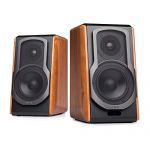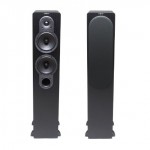Home > Buying Guides > Home Speakers > Floorstanding Tower Speakers vs Bookshelf Speakers | Which One?
Before you choose between which speakers you’re going to get, it’s helpful to understand the positives and negatives of both. “Should I get a floorstanding or bookshelf speaker” is a common question we see all over the web. So we figured we’d address it.
To start, the answer really varies depending on the application and what you’re looking for in a speaker. Let’s begin by defining the two speakers.


There are a number of things to consider when you’re deciding between the two designs. For one, size matters. If you’re looking for a speaker to place on top of a piece of furniture or on a shelf or wall, the bookshelf speaker is probably your choice. Tower speakers are larger, and normally sit directly to the sides of the TV or screen on the floor. Budget is huge too, obviously. Bookshelf speakers are definitely cheaper. You can get a good bookshelf speaker in the $100 range, while a tower speaker set is well into the $300s plus.
Finally there’s sound quality. This is tied to size too. But many experts agree that bookshelf speakers are normally better for accurate, clear sound than floorstanding. But they can’t reproduce the low frequencies very well. Floorstanding speakers have much more power and can handle a wider range of sound though, including the bass.
At the end of the day, there’s a few questions you need to ask yourself to help you deside between the two designs:
- How much am I willing to spend?
- Will I be running a dedicated subwoofer?
- What kind of sound am I looking for? Mids and highs or primarily bass?
- What configuration settings do I have? Will a tower speaker fit?
- What will look the best with my configuration?
These questions will help you narrow your search and come to a conclusion. Heck, you might even want a combination of the two! Whichever you decide, we’ve put together reviews and lists to help you in the next step of the process to purchasing your perfect home theater speakers. Check out our lists of Best Floorstanding Tower Speakers, and our list of Best Bookshelf Speakers.
